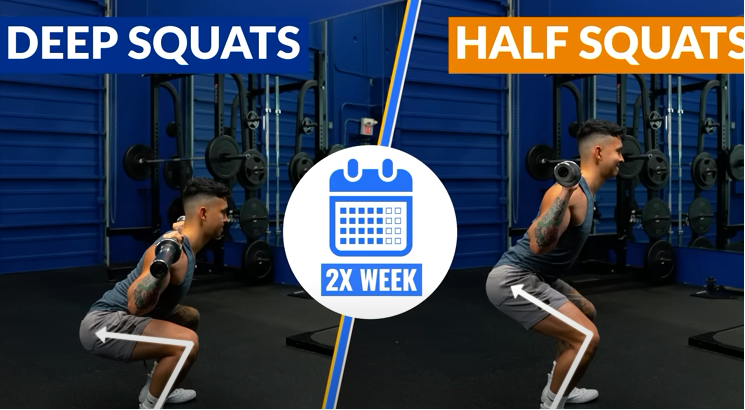Squat is a compound exercise that primarily works the muscles of the legs, including the quadriceps, hamstrings, and glutes. To perform a squat, you stand with your feet shoulder-width apart and your toes pointed slightly outward. Then, you lower your hips down and back as if you are sitting on a chair, while keeping your chest up and your core engaged. You continue lowering until your thighs are parallel to the ground or below, and then you push back up to the starting position by pushing through your heels.
Squats can be done with just your bodyweight, or you can add weights such as dumbbells or a barbell to increase the difficulty. Squats are a popular exercise because they are functional and help to build strength in the lower body, which can be beneficial for everyday activities and athletic performance. They are also a great exercise for burning calories and improving overall fitness.
Squats can be modified to target different muscles and add variety to your workout routine. For example, a narrow stance squat will emphasize your inner thigh muscles, while a wider stance squat will put more emphasis on your glutes and outer thigh muscles. You can also add a jump to your squat to make it a plyometric exercise, which will increase the intensity and work on explosive power.
It’s important to maintain proper form when performing squats to avoid injury and ensure that you are targeting the intended muscles. Common mistakes include letting your knees collapse inward, leaning too far forward, or not engaging your core. A fitness professional can help you learn proper form and provide guidance on how to progress your squatting ability.
In addition to building strength and improving fitness, squats have been shown to have numerous health benefits. They can help improve bone density, promote better balance and coordination, and even increase testosterone levels in both men and women. Squats are also a compound exercise, meaning they work multiple muscles at once, which can be more time-efficient and effective than isolation exercises.
Overall, squats are a versatile and effective exercise that can benefit individuals of all fitness levels and goals. However, as with any exercise, it’s important to start slowly and gradually increase intensity to avoid injury and ensure long-term success.
If you’re new to squats, it’s a good idea to begin with bodyweight squats and focus on getting comfortable with the movement and perfecting your form. As you progress, you can add weights such as dumbbells, kettlebells, or a barbell to increase the challenge.
There are also different variations of the squat that can be incorporated into your workout routine, such as front squats, back squats, and overhead squats. These variations can target different muscles and add variety to your workout routine.
It’s important to include proper warm-up and cool-down exercises when performing squats to prevent injury and reduce muscle soreness. Some helpful warm-up exercises include walking lunges, leg swings, and foam rolling. After your workout, stretching exercises such as hamstring stretches and hip flexor stretches can help reduce muscle tension and soreness.
In summary, squats are a highly effective exercise for building lower body strength, improving fitness, and promoting overall health. With proper form and technique, squats can be performed safely and provide numerous benefits. However, it’s important to start slowly and gradually increase intensity to avoid injury and ensure long-term success. If you’re unsure about how to perform squats or want to improve your technique, consider working with a fitness professional who can provide guidance and support.
In addition to the physical benefits of squats, they can also have a positive impact on mental health. Exercise, in general, has been shown to help reduce symptoms of anxiety and depression, and squats can be a great way to incorporate physical activity into your routine.
Moreover, because squats engage multiple muscle groups at once, they can help you burn more calories in less time compared to isolated exercises, making them a great addition to a weight loss or maintenance program. And since they are a functional exercise, meaning they mimic movements we perform in daily life, squats can help improve overall mobility and make everyday activities easier.
It’s worth noting that squats may not be suitable for everyone, especially those with certain injuries or medical conditions. If you have any concerns, it’s important to talk to your healthcare provider before starting any new exercise program.
In summary, squats are a highly effective exercise that can provide numerous benefits for physical and mental health. Whether you’re a beginner or an experienced fitness enthusiast, there are many variations and modifications of squats that can be incorporated into your routine to keep it challenging and interesting. With proper form, technique, and safety precautions, squats can help you achieve your fitness goals and lead a healthier, more active life.
![]()
